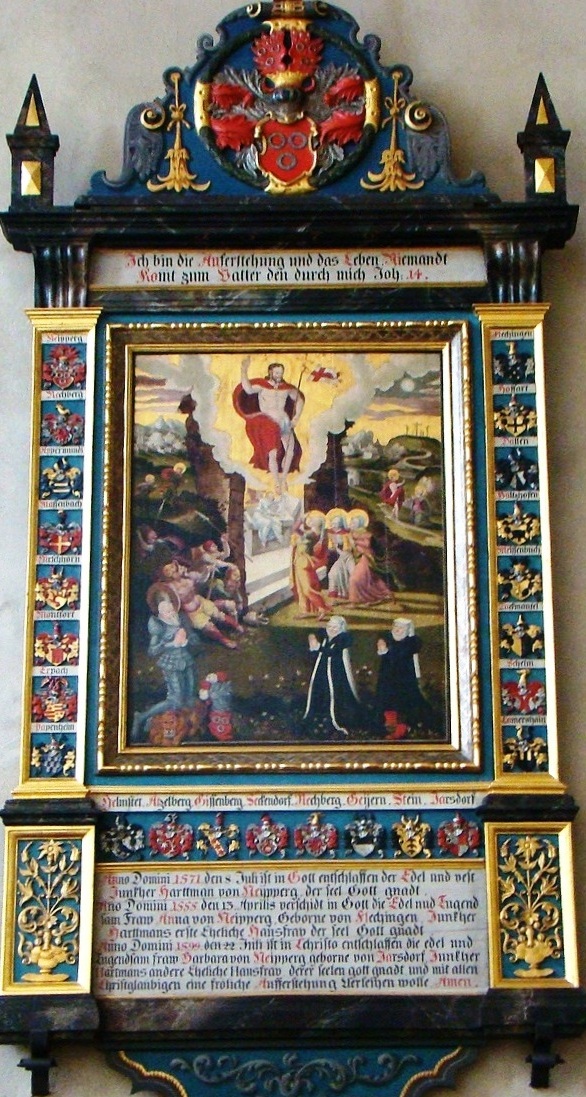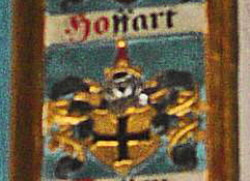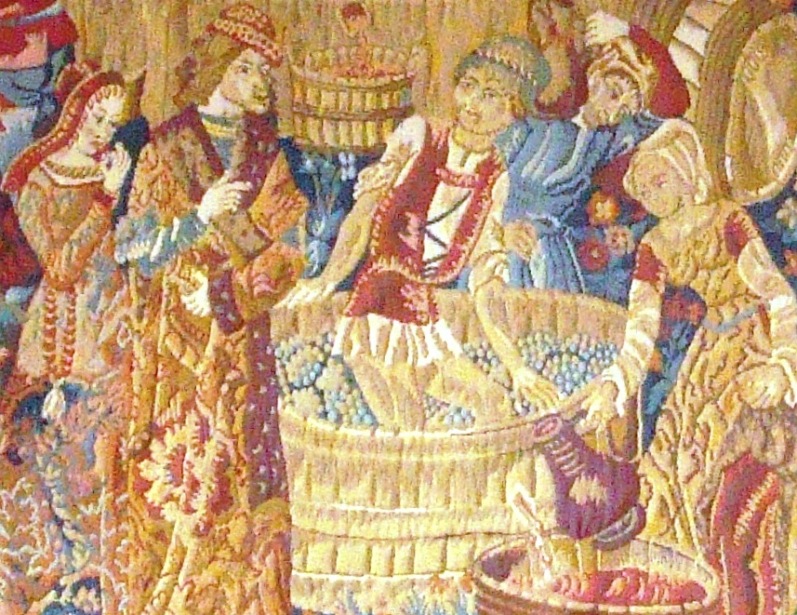Schwaigern, Germany (2011)
| Photo below: The tower of the Evangelical Lutheran Church. |
| My HOFFART (Hufford)
ancestors were connected to that church. In 1729, my
ancestor Hans Jorich HOFFART
left Schwaigern with his wife and children; they moved to
Pennsylvania. They were connected to the German Baptist
Brethren movement, and some local official ordered them
all to leave. Photo
below: Clock face art attached to the church. |
| Photo below: Plaque on exterior wall at church. |
| Photo below:
Stone carving on exterior wall of church. Note the Roman numerals: M.D.X.IIII. In other words, 1000 + 500 + 10 + 4 = 1514. |
| Photo below: Stone carving on exterior wall of church. |
| Photo below: Statue at exterior corner of church. |
| Photo below: Sun dial on exterior wall of church. |
| In October 2011, the
Evangelical Lutheran Church was closed for renovation. However, it is known that within that church is the painting shown below. Photo below: Painting inside
Schwaigern Evangelical Lutheran Church. |

| This painting is a major key in
HOFFART genealogy. Note the decoration at the top of the
framework; you'll see a red shield with three circles. The painting is said to represent "the victorious Christ above the tomb and before the astonished Mary and Martha." In the foreground of the painting is a man in a suit of armor; with him are two woman who are praying. The coat of arms shows the red shield with three circles. That shield identifies him as Gunther Hartman von Neipperg. The two praying women are his two wives; the first of those two wives was a HOFFART descendant. Framing the painting on the sides and the bottom are rows of coats of arms -- eight for each of the three people (Gunther and his two wives). For each of the three people, there were crests for all eight great-grandparents. The crests on the right side are the crests for the wife who was the Hoffart descendant. The second of her family crests is the Hoffart crest -- a golden shield with a bold black cross, with gold and black vines on either side of the shield, and with a helmet with a red plume. Photo below: Close-up of the HOFFART crest in that art. |

| Gunther Hartman von Neipperg's first
wife was Anna von Flehingen who died
April 13, 1555 (buried Schwaigern-Massenback).
Reportedly, she was the daughter of Ulrich von
Flehingen and his wife Anna Hofwart von
Kircheim. The family name for Anna Hofwart von Kircheim was "Hofwart von Kirchheim." Anna von Flehingen (daughter of Anna Hofwart von Kircheim) married Gunther Hartman von Neipperg in 1535. A marriage in 1535 suggests that she was born in about 1515. Unfortunately, we have no information above Hans Hoffart who was born in about 1554 in Schwaigern. Thus, no connection can be proven; it can only be assumed since the family name and location were the same, and since the HOFFARTs who moved to Pennsylvania in 1729 (and their ancestors) had connections to this same church in Schwaigern. But it is those old family crests (or shields) that show the connection. The crests communicate even when spelling and pronounciation mutate over centuries and languages. According to unsourced information at wikipedia, "The family Hofward was a Franconian-Swabian noble family also known by the additional name Kirchheim. It was organized in the Franconian Knightly canton of Odenwald." After coming to America, the HOFFART name mutated and varied to include all of these and others: Hoffarth, Hufford, Huffort, Huffart, Hufferd, Huffert, Hoffart, Hoffard. Photo below: Sign pointing to the Zum Alten Restaurant. |
| Photo below: Zum Alten Hotel & Restaurant. |
| The hotel is owned by
"the Duke." Obviously, there no longer are
"dukes" in Germany. However, there are
"pretenders" to royal titles. And in
Schwaigern, you learn that "the Duke" owns the
hotel and restaurant and that "the Duke" lives
in "the castle." Photo below: Fireplace in Zum Alten Restaurant, with shield of von Niepperg family. |
| The fireplace pictured
above is made from handmade, honeycomb-shaped tiles. The
shield in the middle of the fireplace is the shield of
the von Niepperg family -- red shield with three circles. Photo below: The Castle. |
| Photo below:
Horse trough at the castle. Notice the red shield with the three circles, the von Neipperg family crest. |
| Photo below: From
the inside courtyard at the duke's castle. Notice the steeple of the Evangelical Lutheran Church above the roof. |
| Photo below: The other wing of the duke's castle. |
| Photo below: The private church of the duke. |
| WHY would the duke and
his family need their own private church since the
Evangelical Lutheran Church is immediately next door?
Because the duke's family has always been Roman Catholic,
and Catholics don't go to church at Lutheran churches.
Why does the crest of a Roman Catholic family decorate a
Lutheran church? Because when the church was built in
1514, it was a Catholic church. It was 1517 when the then
Roman Catholic priest Martin Luther nailed his notice on
the door of a Catholic church in Wittenberg. At some time after the church was built, during the Protestant Reformation, the church became a Lutheran church. Once the church next door was a Lutheran church, the von Neipperg family would have needed a Catholic church. The church is not open to the public. It is used for the duke's family only, and not even every Sunday. Reportedly, it is used for family weddings and baptisms. Photo below: Tapestry in the Zum Alten Hotel. |
| This tapestry pictured
above hangs on a wall in a common area in Zum Alten
Hotel, on the 2nd floor (which they call the "1st
floor"). It is about three feet high. It is a
tightly woven tapestry. On top of the tapestry, the
artist did trapunto quilting. The result is that the
tapestry has become three dimensional. The art work
includes lots of grapes, grape making, and wines. Even
today, grape growing and wine making are a major part of
the economy of the region. Photo below: Detail of the above tapestry. |

| From Schwaigern, I drove to Speyer and the Rhine River. |